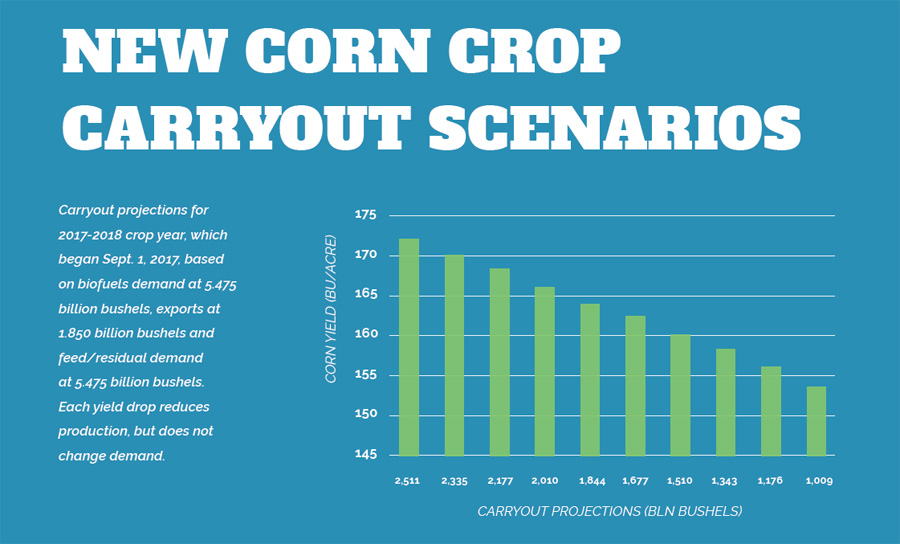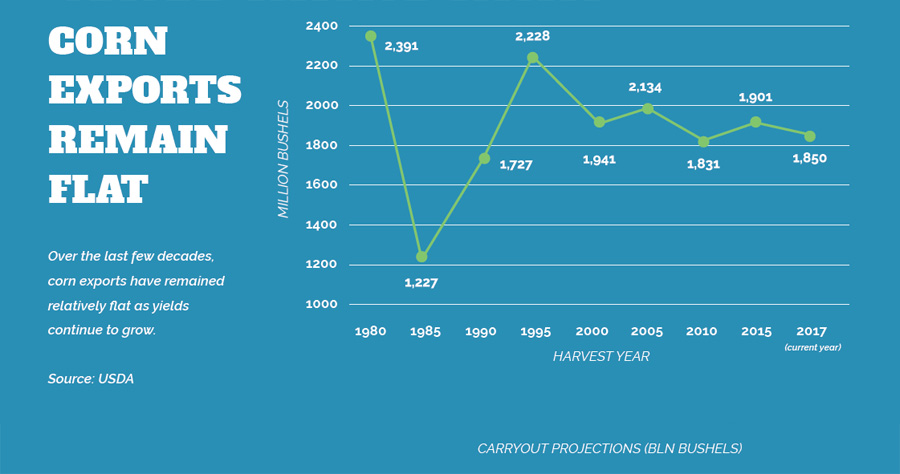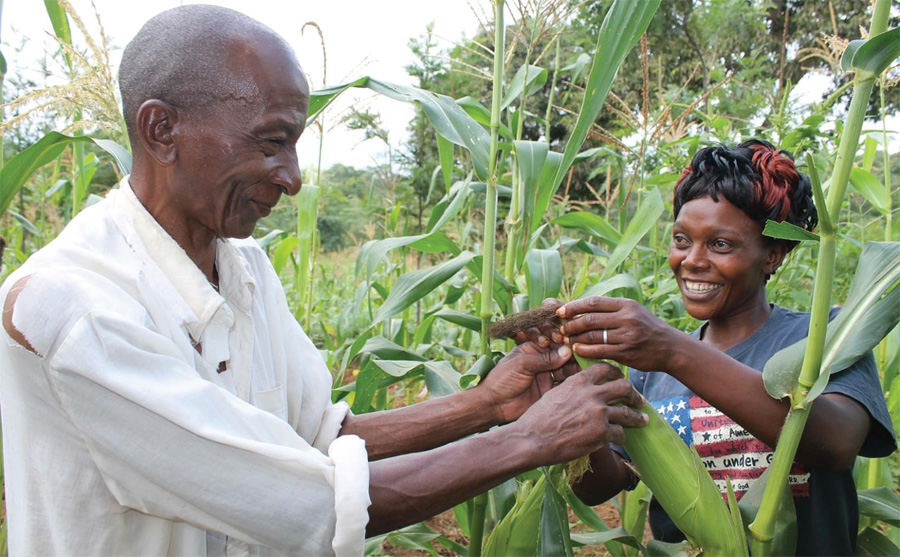When corn prices drop in Iowa, or when excess corn sits in grain bins in South Dakota, it doesn’t just affect America’s farmers and the Midwest economy.
The market conditions in the Midwest can, say, affect the price of commodities in Brazil, or change the quality of steak in China, or threaten the livelihood of a farmer in Kenya.
Today, the current conditions of the U.S. ag economy — fluctuating commodity prices, declining profits, ever-rising corn yields and the excess it creates — has the global ag market on edge.
American farmers are sitting on record amounts of corn. The United States Department of Agriculture (USDA) reported the 2017-18 market year opened with 2.35 billion bushels of corn carryout, or “ending stocks,” the amount left over after the immediate need for a grain has been met. That’s the most in nearly 30 years.
“How do we work through that extra corn inventory?” asks Kip Tom, a seventh-generation farmer and managing member of Tom Farms, an ag sales and service company. While his family’s farm has been rooted in northern Indiana since 1837, his company has become a leader in global crop production. “That excess corn is significant not just for us, but for the worldwide market. That number is going to stay the same or keep growing.”
The export of corn itself would seem to be the easy answer. To those in the know, it’s not. Over the last few decades, corn exports have remained relatively flat — an average of roughly 1.9 billion bushels per year — as yields continue to grow. In 2016, U.S. farmers produced 2.7 billion more bushels of corn than in 2010.
Demand for American corn may not be growing, but competition is. Argentina exported $4.2 billion worth of corn and Brazil exported $3.7 billion during 2016 — a combined total of 27.5 percent of total corn exports. The fastest growing corn exporters by dollar value over the past several years include Mexico (up 104 percent since 2012) and Russia (up nearly 50 percent since 2012).
Kip Tom’s answer — and the answer of many industry experts — comes in the form of biofuels.
“We have to increase demand, and that demand — that growth — is coming from the biofuels sector,” says Tom, who has worked around the globe and recognizes as well as anyone how local farms affect worldwide agriculture. “If we could go from a 10 percent blend to a 15 percent blend, that would use up more of the carryout,” he says. “That would help raise prices for everyone. It not only shores up the U.S. agriculture economy, but it supports the global economy as well.”
And flooding the international market with subsidized corn like we did in the ‘80s and ‘90s, according to POET CEO Jeff Broin, does more than just create a short-term band aid for U.S. farmers. It also threatens the livelihoods and farming futures of sustenance farmers in places like Africa, India, Ukraine and other developing nations. Broin has witnessed this firsthand through trips with Seeds of Change, POET’s notfor- profit organization dedicated to “transforming education, agriculture and environmental conditions worldwide.”
“Increasing biofuels in our fuel supply will be critical as yields continue to rise to stabilize commodity supplies and prices. This allows farmers in the U.S. and developing nations to turn a profit, feed their families and contribute to their nation’s economies,” Broin said.
The global agricultural marketplace, according to Jim Miller, an economist and the president of Agriculture and Biofuels Policy Consulting, continues to grow (in terms of competing countries) and shrink (in terms of interconnectivity).
“We have a global surplus of just about every field crop you can imagine,” says Miller, a former farmer in Washington state who now serves as an ag policy consultant in Washington, D.C. “It’s depressing prices around the world. The global market is getting more sophisticated, and we need to match that sophistication through the things we do well, like ethanol and its value-added products.”
Biofuels and coproducts like DDGS (distillers dried grains with solubles, a nutritious animal feed) and corn oil have shown great potential for opportunities in overseas markets.
“If you are trying to develop a market for just corn, it’s a crowded playground, more so than 20 or 30 years ago,” says Mike Dwyer, Chief Economist for the U.S. Grains Council. “But we have a comparative advantage in all of these valueadded corn products. This year, those exports are going up by 16 percent. That’s corn grind. And ethanol exports are increasing big time. That’s corn grind.”
In 2016, the United States exported more than 1 billion gallons of fuel ethanol (to 34 different countries), a 26 percent increase over 2015, according to the U.S. Energy Information Administration. That’s almost triple the amount exported in 2010.
“In the U.S., we’re efficient corn producers, efficient ethanol producers,” says Dr. Seth Meyer, the Chairman for the World Agricultural Outlook Board at the USDA. “Trade is one of the ways you can put some support under prices. We want to be trade competitive, and we see real room for growth — and real potential — in the coproducts of corn.”
Meyer acknowledges that higher commodity stocks, without new markets, will continue to drive prices lower. “Margins have tightened, and that is certainly posing problems,” says Meyer, who oversees the monthly forecasts of the World Agricultural Supply and Demand Estimates report. “These corn carryout numbers are big, and we do see potential in the ethanol industry for exports — especially in those coproducts.”
Corn yields, meanwhile, continue to increase. The 2016 corn harvest featured record-setting totals: 170 bushels per acre and 14.5 billion total bushels. Similar numbers are expected for 2017. That’s nearly twice the total production from 30 years ago on fewer planted acres. Yet today’s total corn exports — at just under 2 billion bushels — are nearly identical to 1987 numbers. And technology will continue to drive yields even higher: Some experts are predicting nationwide averages of 300-bushel yields within 15 years.
“Biofuels are absolutely one of the answers to help the growing yield rates,” says Barry Dunn, president of South Dakota State University. “First, if we went to E15 or E30, that would increase the demand that’s been missing in the U.S. marketplace. We can also move that corn supply off the market with things like distillers grains and everything that goes along with biofuels.”
Dunn, who was a cattle rancher through the 1980s ag crisis, sees similarities to the ag industry today. “Overproduction and volatility are not helpful, and those issues need to be taken care of, or we’re going to be set up for a really tough time,” he says. “We need people to fight for ethanol, and to realize the full potential it has to help our ag economy, our state’s economy, our nation’s economy and the world economy.”
SUPPORT FOR BIOFUELS INDUSTRY BEGINS AT HOME
One of the policymakers with a history of fighting for biofuels is John Thune, the U.S. Senator from South Dakota.
For Thune, backing the biofuel industry needs to begin here at home, with the continued support of the Renewable Fuel Standard (RFS) and an expansion of the Reid Vapor Pressure (RVP) waiver, which currently places limits on E15 sales during summer months.
“With the current downward trend in the ag economy, the RFS is an essential tool for expanding market access for farmers to sell feedstock for renewable fuels, including ethanol,” says Thune, who has helped author the last three Farm Bills. “Extending the RVP waiver to permit the sale of E15 in the summer travel season would expand ethanol sales, generate higher demand for corn and lead to more certainty for the ethanol market and farmers,” he says. “It would also be a win for consumer choice at the pump by allowing year-round access to E15.”
Still, today’s ag industry continues to increasingly rely on an ever-growing international market, a market in which corn from Indiana can quickly make its way to somewhere like India as a product like corn oil.
“Exports are a promising market expansion for biofuels producers,” says Thune. “Corn yields have increased significantly, resulting in declining corn prices. Increasing biofuel and coproduct exports is an effective measure in maintaining corn prices. We need to continue to look for new markets for ethanol and its byproducts.”
Kip Tom, who has been farming for 44 years, also has three children — the eighth generation of family farmers — working with him.
He just hopes people realize how that farm and bioprocessing plant in Middle America and the production of biofuels and coproducts in South Dakota, for example, can affect that ranch in South Korea or that small family farm in Nigeria.
“Our future centers around biofuels and starch-based ethanol,” says Tom. “I can’t imagine what our country’s economy would look like if we didn’t have biofuels. Right now, we could reduce extra corn inventory simply through more demand for biofuels. We could change the trend of the entire industry. It’s not just about us anymore, it’s about everyone. It’s not just growth for domestic farming, it’s international farming as well. If we do this right, that biofuel from our backyards can help the entire world.”
Flooding the international market with subsidized corn would threaten the livelihood of farmers like Christine Ndula, who stands in her field in Makueni County, Kenya, where she anticipates harvesting 10 bags (approximately 35 bushels) of corn. Seeds of Change’s Mission Grow has helped Ndula and many other farmers increase their crop yields. If she planted local varieties, she would have expected to harvest only six bags (21 bushels) from the same plot.









